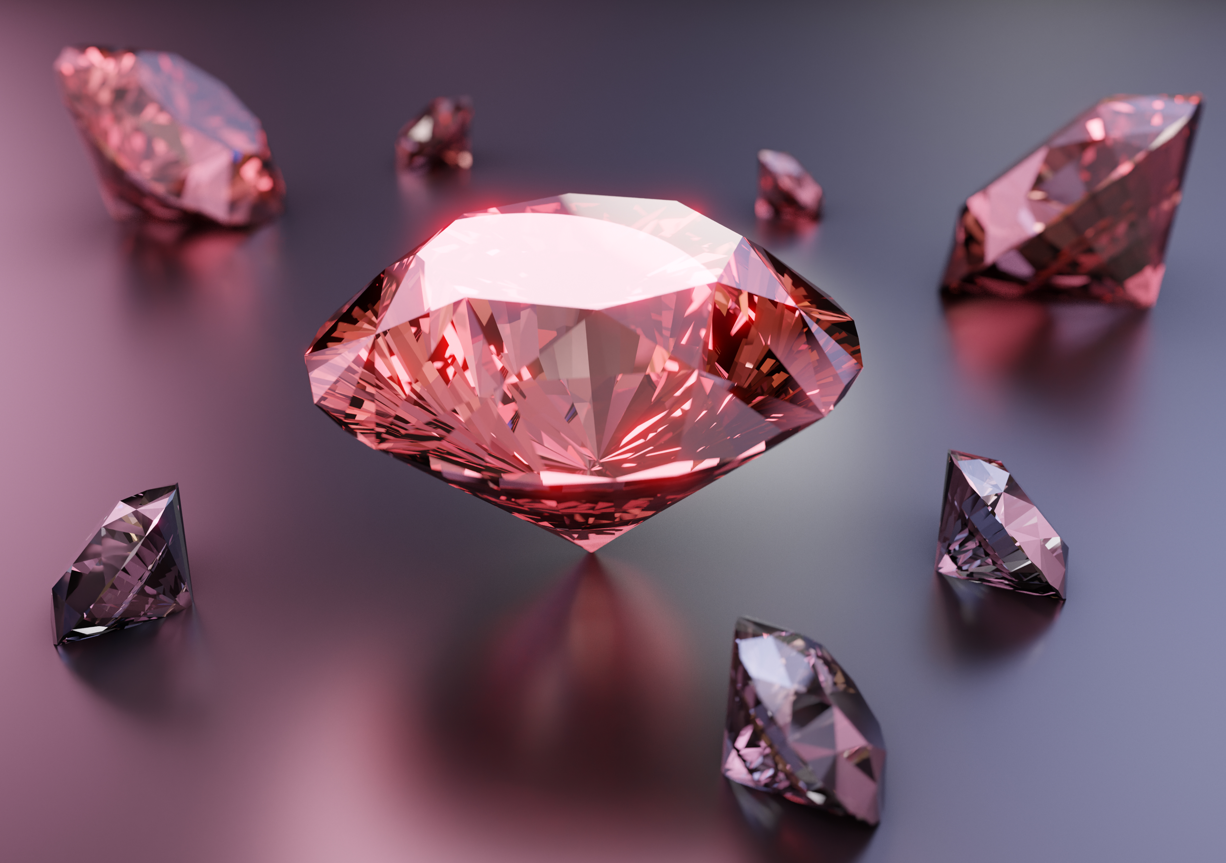Suppose you got a diamond ring for your engagement. It’s just beautiful, but it has come with the guilt that it must have made a larger-than-life hole in your fiancé’s pocket. Relax, it could be a lab-grown diamond, which is as bedazzling as a natural but with a lighter price tag. Obviously, you can’t ask your fiancé about it. Curiosity is eating you up, but so is the fear of being judged or sounding ungrateful. Relax, you are on the right page; this blog will guide you through the whole process of identifying a diamond’s origin without feeling awkward or embarrassed.
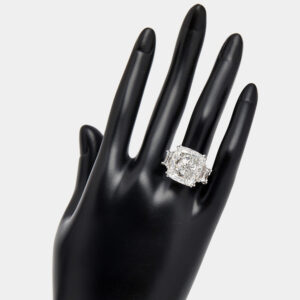
Diamonds dazzle. But not all sparkle comes from ages under Earth’s crust — some equally sparkling are born in labs. As a word, when used independently, ‘Diamond’ primarily signifies a natural diamond. Terms like lab-grown, laboratory-grown, synthetic, or man-made diamond are specified to authenticate the origin or manufacturing process. But what if it’s not mentioned?
-
Can You Tell With Your Naked Eyes a Laboratory-Grown Diamond From a Natural Diamond?
No. Both look identical to the unaided eye. Advances in technology have blurred the line so much that even experienced jewelers usually can’t tell without magnification or instruments. That’s why you need to rely on certifications, inscriptions, and professional testing.
If you want to buy wisely (no regrets later), knowing the difference is more than just trivia — it protects value, ethics, and trust.
-
How Do I Know Whether I’m Purchasing a Natural or a Laboratory-Grown Diamond?
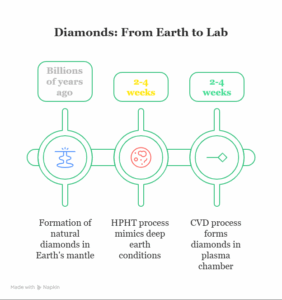
Diamonds may all sparkle the same to a layperson, but not all are created the same way. Some are born deep in the Earth over billions of years, while others are grown inside a lab in just weeks. With lab-grown diamonds often 40–60% cheaper than mined ones, understanding the difference is crucial to preserving both value and trust.
Here’s a clear, expert-backed guide—drawing on insights from the Natural Diamond Council and Grown Diamond Corp—to help you tell them apart.
1. Check for Certification from Reputable Gemological Institutes.

The most reliable way to determine a diamond’s origin is through certification from trusted organizations, such as the Gemological Institute of America (GIA), the International Gemological Institute (IGI), or SGL Labs. These reports detail whether a diamond is natural or lab-grown, as well as other key characteristics, including cut, clarity, and carat weight.
- What to Look For: GIA and IGI reports explicitly state “Lab-Grown” or “Natural” in their documentation. For lab-grown diamonds, the certificate may also mention the growth method (HPHT or CVD).
- Why It Matters: Certifications provide an unbiased, professional assessment, ensuring a seller’s claims do not mislead you.
Tip: Always request to see the original certificate or verify the report number online through the institute’s database.
2. Inspect for Laser Inscriptions Under Magnification
Many diamonds, especially those certified by GIA or IGI, feature microscopic laser inscriptions on their girdle (the diamond’s outer edge). These inscriptions include the certificate number and, for lab-grown diamonds, often indicate their synthetic origin.
- What to Look For: Use a jeweler’s loupe (10x magnification) or a microscope to inspect the girdle for inscriptions such as “Lab-Grown,” “LG,” or the certificate number. Natural diamonds typically only have the certificate number.
- Why It Matters: Laser inscriptions offer a quick and non-invasive method for verifying a diamond’s authenticity, particularly when combined with a corresponding certificate.
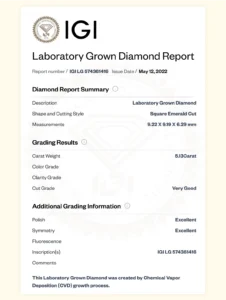
- What the Natural Diamond Council (NDC) says: Legal definitions and advertising guidelines mandate that lab-grown diamonds must be clearly disclosed as such. Certification reports must state whether the stone is natural or lab-grown, and if lab-grown, the specific process used (CVD or HPHT) must be specified.
Tip: Always ask to see the grading report. If the report doesn’t explicitly say “natural,” assume lab-grown or undisclosed. Labels like “diamond” without qualifiers tend to imply natural diamonds legally.
3. Examine Inclusions and Growth Patterns.
While both lab-grown and natural diamonds may have inclusions (internal flaws), their growth patterns differ due to the distinct formation processes involved in their creation. Natural Diamonds form over millions of years under the extreme conditions of Earth, while lab-grown diamonds are created in weeks under controlled environments.
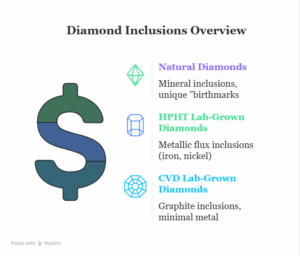
- Natural diamonds: Formed over millions to billions of years deep in Earth’s mantle. Their growth patterns (grain, crystal structure) are complex, often irregular, with inclusions like minerals, feathers, or tiny “nature marks.”
- Lab-grown diamonds, Especially Those Grown Using CVD or HPHT methods, exhibit distinct growth structures. For instance, growth striations, metallic inclusions, or clearer, more uniform features. Under magnification + with specialized tools, these patterns are distinguishable.
- The NDC report notes that because crystals grow differently in natural environments versus laboratory environments, their grain or structural patterns differ, and professional instruments utilize this to distinguish them.
Tip: These differences, though subtle, can be identified by a trained gemologist using a microscope.
4. Use Specialized Testing Methods.
According to the NDC, all lab-grown diamonds can be identified by professionals with the right equipment. Advanced testing methods, typically conducted by gemological laboratories or skilled jewelers, can definitively distinguish between lab-grown and natural diamonds. These tests analyze properties that differ due to the diamonds’ formation environments.
Spectroscopic & Fluorescence Tools
- Fluorescence under UV light: Natural diamonds often contain nitrogen impurities, which affect their fluorescence. Lab-grown diamonds tend to have very low nitrogen or other impurity profiles; their fluorescence response can be more uniform or different under UV or short-wave light.
- Spectroscopy & impurity analysis: Professionals use instruments that can detect trace elements, measure composition, and interpret spectral fingerprints. These include checking nitrogen content and how the diamond responds to UV or infrared light.
- Fourier-Transform Infrared (FTIR) or Raman spectroscopy can detect subtle differences in the diamond’s molecular structure, identifying markers specific to the growth method.
- According to the Natural Diamond Council’s data, lab-grown diamonds produced via colorless processes often remove nearly all nitrogen, which is a common impurity (~99%) in natural diamonds. This leads to different behavior under UV / spectral analysis.
Electrical Conductivity: Some lab-grown diamonds (especially HPHT) conduct electricity due to trace elements, while most natural diamonds do not.
Tip: These tests provide scientific precision, leaving no room for doubt about a diamond’s origin.
5. Seek a Professional Appraisal
When in doubt, a trusted jeweler or certified gemologist can provide an expert appraisal. They combine visual inspection, certification verification, and advanced testing to confirm a diamond’s origin.
- Why It Matters: A professional’s expertise ensures accuracy, especially for high-value purchases, where misidentification could result in significant financial loss.
- How to Choose: Select a jeweler with credentials from organizations like the American Gem Society (AGS) or one who uses GIA/IGI standards.
- Additional safeguards: Utilize ASSURE program tools, which the NDC oversees, for performance testing of verification instruments. Ensure the jeweller or lab uses instruments that have been validated under such programs.
Tip: Avoid appraisals from sellers with a vested interest in the sale, as they may lack impartiality.
FAQs: Common Questions About Identifying Lab-Grown vs. Natural Diamonds.
Why It’s Becoming Harder to Tell Lab-Grown from Natural Diamonds?
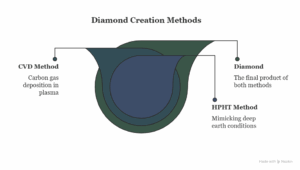
Lab-grown diamonds, created using High-Pressure High-Temperature (HPHT) or Chemical Vapor Deposition (CVD) methods, share the same chemical and physical properties as natural diamonds. Both are composed of carbon atoms in a crystal lattice, making them visually and structurally similar. Modern production techniques have refined lab-grown diamonds to closely mimic natural ones closely, often requiring specialized tools or expertise to distinguish them from natural ones. This similarity, combined with their lower cost (usually 30-50% less than natural diamonds), has made accurate identification critical for buyers seeking transparency.
What Tools Are Used to Detect Synthetic and Natural Diamonds?
Specialized instruments are required. Examples include:
- DiamondView/De Beers testers reveal fluorescence and growth patterns.
- Spectroscopic analyzers measure impurities, such as nitrogen content.
- ASSURE-tested verification devices – certified tools for reliable identification.
Together, these tools make detection close to 100% accurate.
How do I know whether I’m purchasing a natural or a laboratory-grown diamond?
To ensure you’re purchasing the intended type of diamond, always request a certification from a reputable gemological institute, such as GIA or IGI, which clearly states whether the diamond is natural or lab-grown. Additionally, check for laser inscriptions on the diamond’s girdle. Consult a professional gemologist for an appraisal or request advanced testing (e.g., spectroscopy) if no certificate is available. Verifying these details with a trusted, independent source is key to avoiding misrepresentation.
Can you check if a diamond is lab-grown at home?
While basic checks, such as using a jeweler’s loupe to inspect inscriptions or inclusions, can be performed at home, definitive identification often requires professional tools, including spectroscopy or UV testing. For accurate results, consult a gemologist.
Do lab-grown diamonds test as “real” on a diamond tester?
Let’s make one thing clear- lab-grown diamon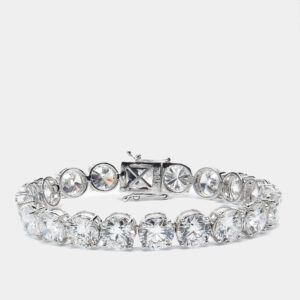 ds are very much real, albeit not natural. Yes, lab-grown diamonds test as natural on standard diamond testers because they have the same chemical composition (carbon) as natural diamonds. Testers distinguish diamonds from simulants, such as moissanite, but not lab-grown diamonds from natural ones.
ds are very much real, albeit not natural. Yes, lab-grown diamonds test as natural on standard diamond testers because they have the same chemical composition (carbon) as natural diamonds. Testers distinguish diamonds from simulants, such as moissanite, but not lab-grown diamonds from natural ones.
How to Buy Smart and Avoid Confusion: Choose The Luxury Closet.
Distinguishing between lab-grown and natural diamonds primarily depends on certification, inspection, and expert verification. Always check for a GIA or IGI certificate, look for laser inscriptions, and seek professional appraisals for high-value pieces. While lab-grown diamonds offer affordability and ethical appeal, natural diamonds remain prized for their rarity and heritage. The key is buying with confidence and transparency.
That’s why The Luxury Closet brings you The Diamond Edit—an exclusive collection of GIA-certified lab-grown diamond jewelry. Curated for clarity, quality, and authenticity, it’s your trusted destination for diamonds that dazzle and are yet affordable without doubt.
The post 5 Ways to Identify a Lab-Grown Diamond from a Natural One. appeared first on Inside The Closet.


